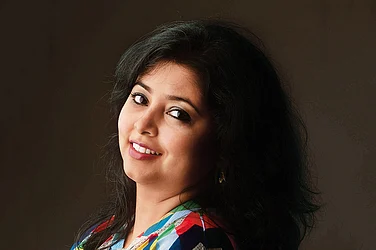In a path-breaking move in early 1900, literature-Nobel laureate Rabindranath Tagore introduced students to the benefits of learning in a natural environment in an open-air campus at Shantiniketan’s Visva-bharati University.
Around 100 years later, 35 km from Shantiniketan, a similar experiment is underway in a school at Suri (pronounced Shiuri), a small town 200 km north of Kolkata. This time, the focus is on giving children — pre-school toddlers, kindergarten and primary school kids — a break from learning by rote, and develop their intuitive thinking and logical reasoning faculties from a very early age. “The idea is also to give children from small towns access to high quality learning from an institution that would be like an IIT of school education,” says Arghya Banerjee, the founder of The Levelfield School.
Why Suri
It all began in 2004 when Banerjee was scouting for a school for his four-year-old daughter in Chennai and Kolkata. He wasn’t happy with what the best K-12 schools even in the major metro cities had on offer. Even the best of schools touted the size of their campus, air-conditioned classrooms, audio-visual equipment — essentially, the infrastructure apparatus. When it came to what-to-teach and how-to-teach, the stress was on learning by rote, and cramming.
Around the same time at his work place, Banerjee, as head of India operations at Irevna, a large equity research outsourcing firm, found it frustrating that highly qualified and skilled knowledge workers that it hired struggled to express themselves clearly and logically in spoken and written English. “Many of them often found it tough to apply what they had learnt in college to solve real-life problems,” says the 36-year-old Banerjee, an alumnus of IIT-Kharagpur and IIM-Ahmedabad. At this point, most people would blame the situation on systemic failures, and move on. But Banerjee took the most unlikely decision — to set up a kindergarten school himself.
He quit his job in 2008 and re-located to Suri, his hometown, to set up The Levelfield School. “I knew people in the town, it was easier to get things moving on the ground within a short time,” he says. He bought a two-acre land parcel on the outskirts of the town for₹15 lakh and got going. “It made sense to start the business from a small town — it cost much less,” he says. Also the impact of what he was out to create would be more felt in a small town than in a metro city. “The question in small towns is not about affordability but access to quality education,” adds Banerjee.
Re-writing rules
Over the next two years, Banerjee along with his wife, began researching on ways to tailor existing curriculum to develop the intuitive thinking faculties of young children. They spent hours re-writing textbooks in simpler language and in a way that would stimulate thinking. Many children’s classics like Gulliver’s Travels and The Prince and the Pauper were re-written and open-ended questions were introduced at end of each story so that students could exercise their mind. To inculcate thinking orientation at an early age, children learn through analytical puzzles like Nanogram, Sudoku, Shikaku and Japanese strategy games such as Go and Gomoku. “We worked to get children to think every day, so that exercising the mind becomes a habit for them,” explains Banerjee.
Price of Quality
Situated five km from town, The Levelfield School — a single storey structure with an under-construction first floor — is ensconced amidst a green belt. There are 12 classrooms with the capacity to take in 400 students in two shifts — pre-primary and primary. Children — typically 15 to 18 in a class — sit on the floor with a study table in front of each. Each class has a projector, a white board, and a laptop for the teacher. Starting off with 70 students in 2010, there are 250 now. Banerjee’s daughter Rhea, who studies in class IV, says the best part of the school was no homework till class III.
The stress is on English-learning with each student reading almost 500 to 1,000 pages in a year, all within the class. To improve spoken English, students and teachers are strictly prohibited to communicate in any other language. The overall focus is on enriching classroom experience. “The school takes complete responsibility for teaching the kids,” says Banerjee. At the time of admission, parents are asked to give an undertaking that the child would not take any private tuition. Children are assessed three times in a year. The first assessment is done in presence of the parent.
At Levelfield, teachers do more homework than students, claims Banerjee. For instance, primary school teachers work from 9 am to 5 pm — just like in an office job, and are well-paid. A pre-primary teacher earns up to₹15,000 per month, while the figure could get as high as ₹18,000 for a primary teacher — almost three times the existing salaries in other local schools. Not surprisingly, up to 60% of school’s operational expense comprises teachers’ salary. “We deliberately recruit teachers who come without prior teaching experience — without a legacy, they are more adaptable to our style of teaching,” says Banerjee. After school hours, teachers chip in to fine-tune teaching material.
Parents fork out ₹1,200 per month as fee for pre-primary classes, and ₹1,500 for primary — that’s double of other English-medium schools in Suri. There is also a one-time admission fee of ₹12,500, inclusive of all teaching material. “Quality education comes at a price” says Banerjee. “But actually, parents realise our fee is not that high because they don’t have to spend on tuitions etc.”
Banerjee kickstarted the venture in June 2009 by pumping in ₹50 lakh from his own savings. He also raised a loan of ₹1 crore from the bank in 2010. He plans to raise an additional ₹50 lakh, through personal savings and internal accruals, by March 2013 to create a 1000-student capacity school.
The school closed FY12 with a topline of ₹30 lakh and while the project was cash flow positive from first month itself, overall break-even after factoring in capital expenditure is expected in 2014, with a topline anywhere between ₹4 to 5 crore. “I will scale up for impact rather than size,” says Banerjee, who wants to have a Levelfield School in 10-12 district centres across West Bengal. However, following his Suri experience Banerjee is in favour of an asset-light strategy when it comes to expansion. “A tie-up with a real estate developer would help. We would like to focus just on managing the operations and running the school,” says Banerjee. A residential boarding school facility at Suri is another idea he is toying with, to keep the fee at affordable levels for locals. Tagore would empathise with this kindred spirit.




























